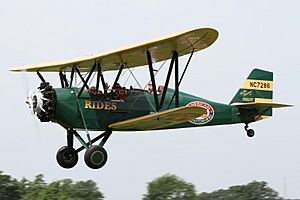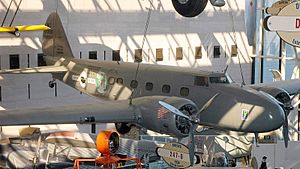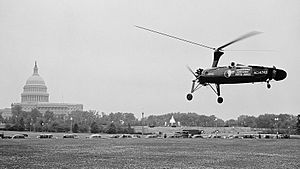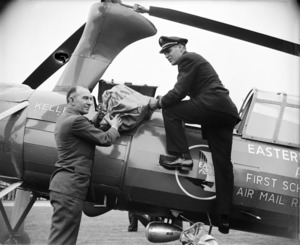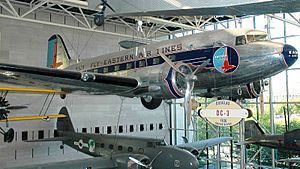Johnny Miller (aviator) facts for kids
Quick facts for kids
Johnny Miller
|
|
|---|---|
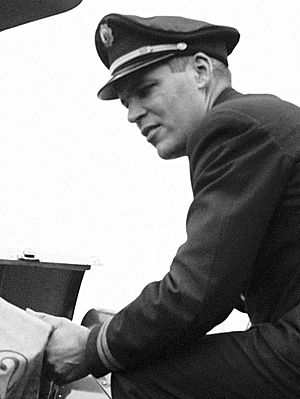
Johnny Miller in 1939
|
|
| Born | 15 December 1905 |
| Died | 23 June 2008 (aged 102) Vassar Brothers Medical Center, Poughkeepsie
|
| Resting place | Poughkeepsie Rural Cemetery |
| Nationality | American |
| Education | Pratt Institute of Technology |
| Known for |
|
| Spouse(s) |
|
| Relatives | Lee Miller (sister) |
| Aviation career | |
| Full name | John MacDonald Miller |
| First flight | 1922 Curtiss JN-4 Jenny |
| Famous flights | First US transcontinental autogyro flight First US rotorcraft scheduled mail service |
| Air force | US Marine Corps |
| Rank | Lieutenant |
John MacDonald Miller (born December 15, 1905, in Poughkeepsie, New York State – died June 23, 2008, in Poughkeepsie) was a famous American pilot. He was known for many firsts in aviation. He was the first person to fly a rotorcraft (like a helicopter) across the United States. He was also the first to land a rotorcraft on a building's roof. Plus, he started the first scheduled mail service using a rotorcraft in the US.
Miller was also a test pilot and an airline captain. He became the oldest active pilot in the US. He made his first flight on his 18th birthday and kept flying until he was 101 years old. He lived to be 102.
Contents
Early Flying Adventures
John Miller was the first child of Theodore and Florence MacDonald Miller. He grew up in Poughkeepsie, New York. His sister, Elizabeth Lee, later became a famous photo-reporter.
When he was just four years old, Miller saw Glenn Curtiss fly. Curtiss was trying to win a big prize for flying from Albany to New York City. This moment made young John decide he wanted to be a pilot. Later, in 1915, he met the famous aviator Ruth Law Oliver and even sat in her plane's cockpit. He studied flying from a book given to him by his uncle.
Miller took his very first flight in a Curtiss JN-4 Jenny plane in the summer of 1922. This happened in Asbury Park, New Jersey.
Barnstorming and Early Career
In 1923, a pilot named Sloan "Swanee" Taylor gave plane rides near Miller's home. Miller, who was 17, helped Taylor fix and maintain his plane. The plane was an old Canadian version of the Jenny. It had bigger wings, which helped it take off and land slower.
At the end of the season, Taylor gave Miller the plane. Miller spent a lot of time repairing it himself. On his 18th birthday, he was practicing on the ground when he accidentally took off! After about an hour of flying and learning how the controls worked, he landed safely. A farmer then asked him for a ride, and Miller started charging $5 per flight. He did more rides, then repaired the plane even more before selling it and going to college.
In 1927, Miller watched Charles Lindbergh take off for his famous flight across the Atlantic Ocean. A month later, Miller finished his mechanical engineering course at Pratt Institute of Technology. He then got his aircraft mechanic's license and worked as a mechanic. In 1928, he earned his pilot's license. He continued to do barnstorming and give pleasure flights in a plane he rebuilt, a Standard J-1. He also started air racing.
Miller later took over and ran the Poughkeepsie Airport in 1931. He mainly focused on repairing and maintaining aircraft there. He also joined the United States Marine Corps Reserve and served as a qualified naval aviator for a while.
Autogyro Pioneer
First Transcontinental Flight
Miller became very interested in autogyros. These aircraft use a spinning rotor to create lift, but they are pushed forward by a propeller, unlike helicopters. In 1929, he ordered a Pitcairn PCA-2 autogyro. He was the first private person in the US to buy one.
Miller then planned to make the first transcontinental (coast-to-coast) autogyro flight. He learned that famous aviator Amelia Earhart was also planning a similar flight. Miller trained hard and planned carefully. He took delivery of his new autogyro, which he called 'Missing Link', on May 12, 1931.
Just two days later, on May 14, he began his flight from Willow Grove, Pennsylvania. He flew across the country, stopping at different places, and arrived in San Diego, California, on May 28. He spent 43.8 hours in the air and had no mechanical problems. This flight set a record that lasted for 72 years!
Amelia Earhart started her flight later and had some publicity stops. She was disappointed to learn that Miller had already completed his journey.
Over the next four years, Miller showed off his autogyro at air shows. He even learned to loop it, becoming the first person to loop a rotorcraft. He was paid well for his displays. In 1932, during a show, his autogyro was hit by another plane after a mock dogfight. Miller was unharmed, but his autogyro was damaged and needed repairs.
Flying Mail for Eastern Air Lines
In 1936, Miller joined United Airlines as a co-pilot, flying large planes like the Boeing 247. He flew with United for about 18 months.
Then, a company called Kellett asked Miller to be the test pilot for their new autogyro, the Kellett KD-1. This new design didn't need wings because the rotor handled all the control. Other pilots were scared to fly it, but Miller believed it was safe. He successfully tested the aircraft, even doing a dive, which was very challenging.
This success led Kellett and Miller to propose using autogyros for mail service. A law was passed in 1938 that made it easier for rotary-winged aircraft to fly mail.
Kellett and Miller then approached Eastern Air Lines. They wanted to fly mail between the main post office in Philadelphia and an airport in New Jersey. This would save a lot of time. Eastern Air Lines was very interested, and Miller became the chief pilot for this operation.
On May 19, 1938, Miller made a demonstration mail flight in the KD-1 autogyro. The mail service officially started on June 6, 1939. This was the world's first mail service using a rotary-wing aircraft, and the first to use a building's roof for landings and takeoffs. Miller did most of the flying, making five round trips a day, six days a week. The service was a big success. The contract ended in 1940, and Miller then joined Eastern Air Lines as a regular pilot.
Later Career and Achievements
With Eastern Air Lines, Miller flew many different types of planes, including the Douglas DC-3, Lockheed Constellation, and Douglas DC-8. He also became a chief test pilot for the Columbia Aircraft Corporation, testing planes like the Grumman J2F-6 Duck.
For the last part of his career, he flew his own small plane, a Beech Bonanza, every day to commute to the New York airports where he was scheduled to fly. He claimed he was the only airline pilot in the area who did this.
Miller left Eastern Air Lines in 1965, having flown over 35,000 hours. He then bought a Bell 47G helicopter and did contract work, often for the police, until 1971. After that, he retired from commercial aviation.
In 2001, at age 94, Miller repeated his transcontinental autogyro flight, but this time in his Bonanza plane. It was a more relaxed trip, with stops at air shows and other places. He reached San Diego and then flew back, completing the journey in 35.5 hours of flying.
He continued to fly his planes from Poughkeepsie until he finally gave up his pilot's license in 2006. For a few years before that, the aviation authority required him to fly with a safety pilot, but Miller always insisted on flying the plane himself. He was known as the oldest pilot in the US.
Miller wrote a book called Flying Stories: A Chronicle of Aviation History from Jennys to Jets by the Pilot Who Flew Through It All, published in 2002. In 2006, at 100 years old, he took his first glider flight and enjoyed it so much he went up again.
Miller received several awards for his contributions to aviation. He got the Sikorsky Award for his role in helicopter development and a Certificate of Honour for his work in aviation. He was also made an honorary fellow of the Society of Experimental Test Pilots for his dedication to flight safety.
Two planes that Miller flew are now on display at the National Air and Space Museum in Washington, D.C.: a Boeing 247D and a Douglas DC-3. Other planes he tested are also in museums.
Personal Life
Johnny's younger sister, Elizabeth Lee Miller, became a well-known photographer.
Miller married Katherine North Sague in 1933. They had three children: Patricia, Joanne, and John Sague Miller. Katherine passed away in 1963. Three years later, he married Dr. Edith Mead, who passed away in 1991.
John Miller passed away on June 23, 2008, at the age of 102, in Poughkeepsie.


